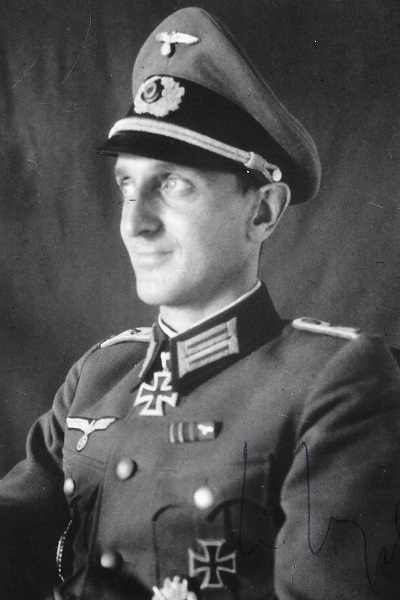Seyrl, Rudolf (Panzergrenadier-Regiment 73)
- Date of birth:
- January 8th, 1916 (Wels, Austria-Hungary)
- Date of death:
- December 10th, 2005 (Hall in Tirol, Austria)
- Nationality:
- German (1933-1945, Third Reich)
Biography
Do you have more information about this person? Inform us!
- Period:
- Second World War (1939-1945)
- Period:
- Second World War (1939-1945)
- Period:
- Second World War (1939-1945)
- Period:
- Second World War (1939-1945)
- Rank:
- Hauptmann (Captain)
- Unit:
- Chef, 1. Kompanie, Schützen-Regiment 73, 19. Panzer-Division, Heer
- Awarded on:
- July 7th, 1942
- Period:
- Second World War (1939-1945)
- Period:
- Second World War (1939-1945)
- Rank:
- Hauptmann (Captain)
- Unit:
- Führer, I. Bataillon, Panzergrenadier-Regiment 73, 19. Panzer Division, Heer
- Awarded on:
- May 14th, 1944
“A Knight’s Cross Holder from the Upper Danube:
The Führer has awarded the Knight’s Cross of the Iron Cross to Hauptmann Rudolf Seyrl, Bataillon commander in a Panzer-Division…
It was in those stormy days of the endlessly raging Soviet offensive. Hauptmann Seyrl’s Bataillon had been involved in non-stop combat operations since the major retreat battles around Zhitomir in December 1943. The Panzergrenadiers of the Division lived and fought amongst the winter storms of the east and in spite of the non-stop enemy surge across the Steppe. The snowy desert had been transformed into muddy fields by bursts of rain, and it was in these conditions that the Hauptmann’s Panzergrenadiers engaged in major defensive combat for an important road. The far numerically superior enemy attacked by both day and night with unceasing fury. They wished to force a penetration at this important point. Masses of tanks and ground attack aircraft hurled themselves against the position of the Panzergrenadiers, however the latter managed to get the best of their opponents from their muddied-out foxholes and trenches. The Bataillon held its position even as the enemy broke through on both flanks and cut off its rearward connections. Hauptmann Seyrl made the independent decision to hold out while in the middle of the Bolshevik time.
Leading at the head of his men, he resisted the enemy for 4 days long. The brave Bataillon acted as a unbreakable bulwark amongst the Bolshevik storm waves. However it was not only the destiny of this German Bataillon that was decided during these 4 days. The 4-day long self-sacrificing stand of this Bataillon enabled the Division to pull pack from a superior opponent and create a new defensive line. But eventually the worst passed, and the Division became ready to fight from its new position. It was only now that Seyrl’s Bataillon fought its way back through the enemy lines and reinserted itself back into the German defensive front.
Three days later Hauptmann Seyrl was wounded for the fourth time in this war. He received this high award in a general hospital in the homeland, far from his Bataillon. May the associated joy contribute to his swift and complete recovery.”
Sources
- Photo 1: Known to STIWOT
- - Die Ordensträger der Deutschen Wehrmacht - Neue Warte am Inn, Edition 26, Page 3.









